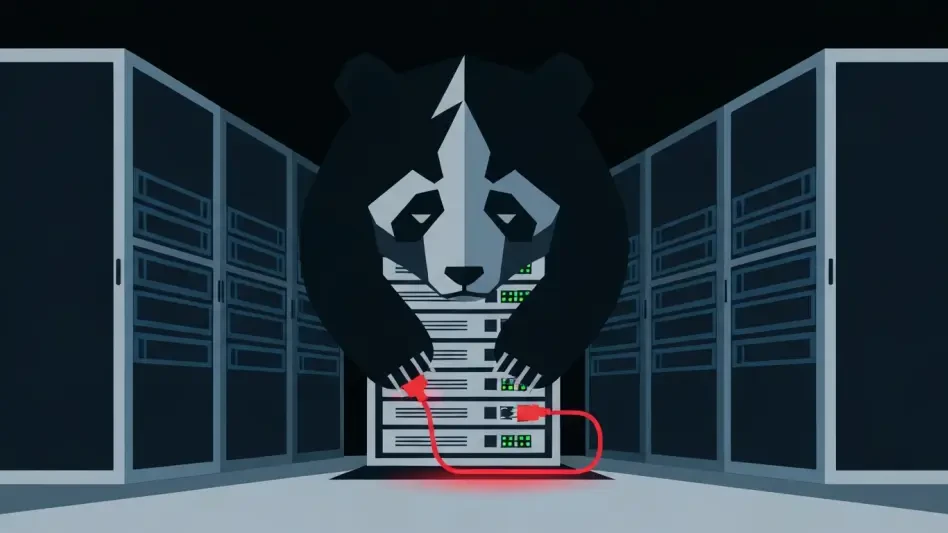In the ever-shifting landscape of cyber espionage, few threat actors have demonstrated the adaptability and persistence of APT24, a group linked to the People’s Republic of China (PRC). Over a span of three years, this sophisticated entity has transformed its approach from broad, opportunistic attacks to highly targeted, multi-vector campaigns that challenge even the most robust cybersecurity defenses. Tracked extensively by the Google Threat Intelligence Group (GTIG), APT24’s evolution reveals a calculated blend of technical innovation and psychological manipulation, with a particular focus on organizations in Taiwan. This shift not only underscores the group’s growing prowess but also raises critical questions about the future of digital security in an era of increasingly complex threats.
What sets APT24 apart is their ability to pivot strategies seamlessly, exploiting diverse attack vectors to maximize impact. From leveraging legitimate cloud platforms to orchestrating supply chain compromises, their operations reflect a deep understanding of both technological vulnerabilities and human behavior. At the heart of their arsenal lies BADAUDIO, a custom malware designed for stealth and persistence, which has become a cornerstone of their espionage efforts. As defenders scramble to keep pace, APT24’s tactics serve as a stark reminder of the dynamic nature of cyber threats and the urgent need for innovative countermeasures.
Evolution of APT24’s Cyber Espionage Tactics
From Web Compromises to Targeted Attacks
The early stages of APT24’s campaign, beginning several years ago, were characterized by a scattershot approach that prioritized volume over precision in targeting potential victims across various sectors. Strategic web compromises formed the backbone of their initial efforts, where malicious JavaScript was injected into legitimate websites to ensnare a wide array of users. Through browser fingerprinting, APT24 refined their focus to high-value targets, particularly Windows users, ensuring that their malware deployment was not wasted on irrelevant systems. This opportunistic method allowed the group to cast a broad net, gathering intelligence from diverse sources while laying the groundwork for more sophisticated operations. The sheer scale of these early attacks highlighted a willingness to exploit any accessible vulnerability, regardless of the specific target, as long as it provided a foothold for further infiltration.
As time progressed into recent years, APT24’s tactics evolved dramatically, shifting toward precision and high-impact strategies that demonstrated a deeper strategic intent. The transition to multi-vector attacks became evident with the adoption of supply chain compromises and spear phishing, which offered greater control over who was targeted and how. A notable example is the compromise of a regional digital marketing firm in Taiwan, which affected over 1,000 domains through the insertion of malicious scripts into widely used libraries. This move away from broad web exploits to targeted, scalable operations reflects a maturation in APT24’s approach, focusing on trusted intermediaries to amplify their reach while maintaining a lower profile. Such adaptability poses significant challenges for defenders, as it requires anticipating not just technical exploits but also the exploitation of trusted relationships.
Strategic Use of Social Engineering
APT24’s phishing campaigns reveal a sophisticated grasp of human psychology, often employing emotionally charged lures to bypass rational scrutiny and prompt user interaction with malicious content. Disguised as communications from animal rescue organizations or other empathetic causes, these emails are crafted to tug at heartstrings, increasing the likelihood that recipients will click on embedded links or download attachments. This calculated manipulation, paired with technical exploits, showcases a dual-pronged approach where the human element becomes as critical a target as the system itself. By exploiting universal emotions like compassion, APT24 ensures higher success rates in delivering malware like BADAUDIO, turning unsuspecting users into unwitting entry points for espionage. This tactic underscores the importance of user education as a frontline defense against such deceptive strategies.
Beyond emotional manipulation, APT24 enhances the effectiveness of their phishing efforts by leveraging legitimate cloud services to host and distribute malicious payloads, thereby cloaking their intent under a veneer of trust. Platforms like Google Drive and OneDrive, widely recognized and trusted by users, are exploited to store encrypted archives containing BADAUDIO, reducing suspicion and bypassing initial security filters. Additionally, pixel tracking links embedded in emails allow the group to confirm user engagement before unleashing the full infection chain, ensuring resources are allocated only to validated targets. This level of precision in targeting reflects a strategic allocation of effort, focusing on individuals or entities most likely to yield valuable access. Such methods highlight the evolving nature of phishing, where blending into legitimate digital ecosystems complicates detection and mitigation efforts.
Technical Sophistication of BADAUDIO Malware
Stealth and Obfuscation Techniques
At the core of APT24’s technical arsenal, BADAUDIO stands out as a meticulously engineered downloader designed to evade even the most advanced detection mechanisms employed by cybersecurity professionals. Built in C++, this malware employs control flow flattening, a complex obfuscation method that disrupts linear code execution by fragmenting it into disjointed blocks managed by a central dispatcher. This technique significantly hampers reverse engineering efforts, as analysts must painstakingly trace non-intuitive execution paths to understand its functionality. Furthermore, BADAUDIO operates as a malicious Dynamic Link Library (DLL), exploiting DLL Search Order Hijacking to execute through legitimate applications, thereby blending into normal system processes. Such stealth features ensure that the malware remains undetected for extended periods, providing APT24 with persistent access to compromised networks while minimizing the risk of exposure.
Beyond obfuscation, BADAUDIO’s design prioritizes minimal footprints through in-memory execution of decrypted payloads, a tactic that reduces detectable artifacts on disk and frustrates traditional antivirus solutions. Upon infection, it collects basic system information such as hostname, username, and architecture, encrypting this data with a hard-coded AES key before transmitting it via cookie values in HTTP requests to a command and control (C2) server. This encrypted communication further shields APT24’s activities from network monitoring tools, ensuring that defenders face significant hurdles in identifying and disrupting the infection chain. The malware’s ability to adapt its behavior based on C2 instructions adds another layer of complexity, as it can tailor subsequent actions to the specific environment it encounters. This relentless focus on evasion underscores the challenges faced by security teams in countering such advanced threats.
Integration with Secondary Payloads
BADAUDIO’s role as a first-stage downloader is pivotal, acting as the initial foothold that paves the way for more destructive tools to infiltrate victim networks under APT24’s control. Once embedded, it fetches encrypted secondary payloads from C2 servers, decrypting and executing them directly in memory to avoid leaving traces on the system’s storage. A frequent companion in these operations is Cobalt Strike Beacon, a commercial penetration testing tool repurposed for espionage, which enables deeper network reconnaissance and lateral movement. The seamless integration of such secondary tools demonstrates APT24’s modular approach, where each component of the attack chain is designed to build upon the previous one, escalating access and control with minimal visibility. This layered methodology ensures that even if initial detection occurs, the full scope of the compromise remains obscured.
The use of Cobalt Strike Beacon, often identified by unique watermarks in APT24’s campaigns, points to a standardized toolkit that may be shared among PRC-nexus threat actors, facilitating rapid deployment across multiple operations. This secondary payload enhances the group’s ability to maintain long-term access, exfiltrating sensitive data or establishing backdoors for future exploitation. BADAUDIO’s multi-layered execution chains, often involving encrypted archives, VBS scripts, BAT files, and LNK files, automate persistence and sideloading, ensuring that the malware re-establishes itself even after system reboots or security sweeps. Such technical sophistication highlights the necessity for defenders to adopt equally dynamic detection strategies, focusing on behavioral anomalies rather than static signatures to identify and disrupt these advanced infection chains before they fully unfold.
Supply Chain Attacks and Regional Targeting
Compromise of Taiwanese Digital Marketing Firm
APT24’s strategic pivot to supply chain attacks marks a significant escalation in their cyber espionage efforts, with the compromise of a Taiwanese digital marketing firm serving as a prime example of their innovative approach to achieving scale. By targeting this intermediary, the group injected malicious scripts into a widely used JavaScript library, impacting over 1,000 domains that relied on the firm’s services for content delivery. Tactics such as typosquatting—mimicking legitimate Content Delivery Networks (CDNs)—and hiding malicious code within JSON files allowed APT24 to evade initial scrutiny, exploiting the inherent trust in third-party services. This attack vector not only amplified their reach but also provided a layer of deniability, as infections appeared to originate from trusted sources rather than direct malicious entities. The sheer breadth of this compromise illustrates the cascading risks posed by supply chain vulnerabilities in interconnected digital ecosystems.
GTIG’s response to this supply chain breach involved extensive remediation efforts, including victim notifications and the development of custom detection logic to block malicious scripts across affected domains. Despite these interventions, APT24’s persistence was evident through multiple re-compromises of the same firm, suggesting a determined effort to retain this high-value access vector. The use of dynamic dependency loading, incorporating legitimate libraries like jQuery and FingerprintJS, ensured consistent execution across varied environments while further obscuring malicious intent. This incident underscores the critical need for organizations to scrutinize third-party dependencies and implement rigorous monitoring of external scripts. As supply chain attacks become a favored tactic among sophisticated threat actors, the ripple effects of such compromises demand a reevaluation of trust models in digital infrastructure.
Geopolitical Focus on Taiwan
The pronounced focus on Taiwan in APT24’s recent operations suggests a deliberate regional targeting strategy that carries significant implications for cybersecurity in the area. From supply chain attacks on local firms to tailored phishing campaigns, the group’s efforts appear to prioritize entities within this specific geopolitical context, potentially driven by broader strategic objectives. While the exact motivations remain speculative, the pattern of conditional script loading—where malicious payloads are activated based on specific domain names—indicates a calculated intent to impact Taiwanese organizations disproportionately. This regional emphasis not only heightens the risk for local businesses and government entities but also signals a need for heightened vigilance and specialized defensive measures tailored to these targeted threats.
Beyond individual attacks, the focus on Taiwan aligns with observed trends among PRC-nexus threat actors, where regional priorities often intersect with espionage goals aimed at gathering intelligence or influencing outcomes in areas of strategic interest. The implications extend to international cybersecurity collaboration, as defending against such targeted campaigns requires sharing threat intelligence and resources across borders to anticipate and mitigate risks. For Taiwanese organizations, this means adopting robust endpoint protection, network monitoring, and employee training to counter both technical exploits and social engineering tactics. Additionally, the broader cybersecurity community must consider how such regional targeting could set precedents for similar campaigns elsewhere, necessitating a proactive stance to protect vulnerable sectors against evolving threats like those posed by APT24.
Defensive Measures and Industry Collaboration
GTIG’s Proactive Response
In the face of APT24’s sophisticated campaigns, GTIG has played a pivotal role in orchestrating a proactive defense, equipping the cybersecurity community with actionable tools to disrupt these persistent threats. Safe Browsing protections have been enhanced to block malicious domains and scripts associated with APT24’s operations, significantly reducing the risk of initial infection for users worldwide. Victim notifications have also been a critical component, alerting affected organizations to compromises and enabling swift remediation before further damage occurs. By sharing Indicators of Compromise (IOCs) and YARA rules tailored to detect BADAUDIO and related payloads, GTIG empowers defenders to identify and neutralize threats within their networks. These collaborative efforts highlight the importance of industry-wide cooperation in addressing the scale and complexity of state-sponsored cyber espionage.
Moreover, GTIG’s integration of custom detection logic into broader security frameworks ensures that even nuanced tactics, such as those employed in supply chain attacks, are flagged and mitigated effectively across diverse environments. The emphasis on disrupting phishing campaigns through spam filtering and redirecting malicious emails further demonstrates a multi-layered approach to defense, tackling both technical and human-centric attack vectors. While these measures have achieved notable successes in curbing APT24’s reach, they also reveal the necessity for continuous updates to counter the group’s evolving methods. The proactive stance taken by GTIG serves as a model for how threat intelligence can be leveraged to build resilience, encouraging other organizations to adopt similar strategies in sharing data and fortifying defenses against advanced persistent threats.
Challenges of Adapting to APT24’s Agility
APT24’s operational agility, characterized by frequent infrastructure shifts and adaptive payload delivery, presents a formidable challenge for defenders striving to maintain effective countermeasures against their espionage campaigns. The group’s habit of using newly registered or previously compromised domains for command and control (C2) communications ensures that static blocklists quickly become outdated, requiring constant monitoring and updates to remain relevant. Additionally, their ability to tailor infection chains based on C2 logic and browser fingerprinting means that only validated targets receive the full payload, minimizing exposure to security tools and complicating efforts to predict attack patterns. This dynamic approach to evasion demands that cybersecurity solutions evolve beyond traditional signature-based detection, focusing instead on behavioral analysis to identify anomalies indicative of APT24’s presence.
The persistent use of legitimate infrastructure, such as cloud services for hosting malware, further exacerbates the difficulty of distinguishing malicious activity from normal traffic within complex network environments. Defenders must grapple with the dual challenge of protecting against technical exploits while educating users to recognize sophisticated social engineering tactics, a balance that requires significant resources and coordination. As APT24 continues to refine their stealth techniques, including multi-layered obfuscation in BADAUDIO, the cybersecurity community faces an ongoing race to develop and deploy advanced detection methods. Sustained vigilance, coupled with real-time threat intelligence sharing, remains essential to keep pace with such adaptable adversaries, ensuring that defenses are not only reactive but also anticipatory in addressing emerging risks posed by multi-vector attacks.








